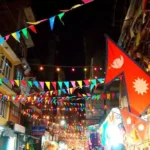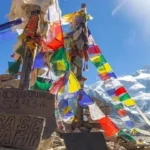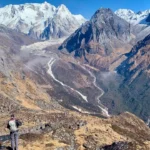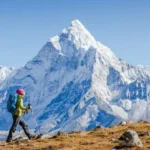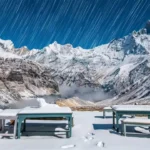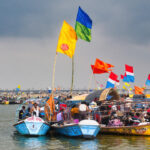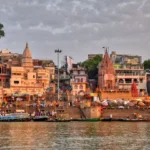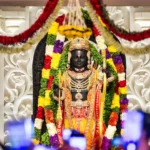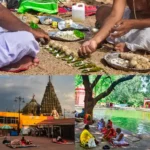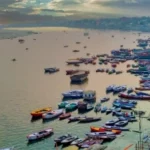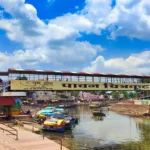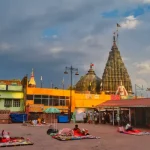The Birthplace of Enlightenment: Monasteries in Lumbini
Lumbini, a UNESCO World Heritage Site in the Rupandehi district of Nepal, holds paramount importance as the birthplace of Siddhartha Gautama, the Lord Buddha. The vast Lumbini Development Zone is a spiritual complex featuring monasteries built by various Buddhist nations, each reflecting their unique architectural styles and interpretations of Buddhist teachings.

Maya Devi Temple: The Sacred Birthplace
Overview: While not a monastery in the traditional sense, the Maya Devi Temple is the central and most sacred site in Lumbini. It marks the exact spot where Queen Maya Devi gave birth to Siddhartha Gautama.
Historical Significance: Archaeological excavations within the temple have unearthed evidence of an ancient brick structure dating back to the 3rd century BCE, possibly the oldest Buddhist shrine. The Ashoka Pillar, erected by Emperor Ashoka in 249 BCE, further confirms Lumbini’s historical significance as the Buddha’s birthplace.
Cultural Insights: Visitors can observe the sacred Marker Stone, indicating the precise birth spot, and the ancient ruins. The serene atmosphere under the Bodhi tree and the sacred Pushkarini pond nearby invite quiet reflection. The entire site is a testament to the beginning of a profound spiritual movement.
Royal Thai Buddhist Monastery: A Taste of Thai Architecture
Overview: This imposing and beautiful monastery in Lumbini is a stunning example of Thai wat-style architecture, featuring intricate gold and white designs.
Historical Significance: Built by the Royal Thai government, it serves as a centre for Buddhist practices and a meditation centre, reflecting Thailand’s deep devotion to Buddhism.
Cultural Insights: The monastery’s serene ambience, combined with its elaborate carvings and elegant structures, offers a peaceful space for prayer and meditation. It’s a striking architectural contrast to the traditional Nepali style seen elsewhere.
Myanmar Golden Temple: Burmese Grandeur
Overview: The Myanmar Golden Temple, also known as the Lokamani Cula Pagoda, is one of the oldest and most elaborate structures in the Lumbini monastic zone, showcasing rich Burmese architectural traditions.
Historical Significance: Its longevity and intricate design make it a significant representation of Myanmar’s contribution to the Lumbini development project.
Cultural Insights: With its stunning golden roofs and detailed craftsmanship, the temple provides a glimpse into Burmese Buddhist art. The quiet prayer halls are ideal for spiritual immersion.
Zhong Hua Chinese Buddhist Monastery: A Symbol of Sino-Nepali Ties
Overview: Popularly known as the China Temple, this elegant monastery in Lumbini is a grand complex built in the traditional Chinese style, with multiple prayer halls, pagodas, and lush gardens.
Historical Significance: The monastery symbolises the strong cultural and religious ties between China and Nepal, with China being home to a vast Buddhist population.
Cultural Insights: The tranquil environment and exquisite architecture offer a peaceful setting for visitors. It’s a place where you can witness Chinese Buddhist practices and appreciate the unique blend of spirituality and aesthetics.
Korean Temple (Dae Sung Shakya Sa): Korean Serenity in Nepal
Overview: The Dae Sung Shakya Sa, or Korean Temple, is one of the tallest and most colourful monasteries in the Lumbini monastic zone, reflecting modern Korean architectural influences.
Historical Significance: Built by the Korean Buddhist community, it serves as a pilgrimage and retreat centre for Koreans and other devotees.
Cultural Insights: The vibrant colours and unique design make it a distinctive presence in Lumbini. The monastery also uniquely offers community sleeping areas and meals for visitors at a minimal cost, fostering a sense of shared spiritual journey.
World Peace Pagoda: A Universal Symbol of Peace
Overview: Also known as the Japan Peace Stupa, the World Peace Pagoda is a magnificent white monument dedicated to world peace, built by Japanese Buddhists.
Historical Significance: Part of a global initiative by the Nipponzan Myohoji order to build Peace Pagodas worldwide, this stupa in Lumbini is a powerful symbol of peace and non-violence at the birthplace of the Buddha.
Cultural Insights: The serene environment surrounding the pagoda, with its gilded Buddha statues, invites contemplation and offers breathtaking views. It’s a testament to the universal message of peace that Buddhism embodies.
High Altitude Spirituality: Monasteries in the Everest Region
For trekkers and spiritual seekers venturing into the Khumbu (Everest) region, the monasteries nestled amidst the towering peaks offer a profound connection to Sherpa culture and ancient Buddhist traditions.

Tengboche Monastery: Gateway to Everest Spirituality
Overview: Tengboche Monastery is arguably the most famous and largest monastery in the Everest region, strategically located on a ridge with panoramic views of Mount Everest, Lhotse, and Ama Dablam.
Historical Significance: Founded in 1916 by Lama Gulu, it has served as a pivotal spiritual centre for the Sherpa community. It was largely rebuilt after being destroyed by an earthquake in 1934 and a fire in 1989. It is famous for the annual Mani Rimdu festival.
Cultural Insights: Trekkers often stop at Tengboche to receive blessings from the head lama for a safe journey. The monastery is a vibrant hub of Sherpa culture and Buddhist practices, with daily prayers and a fascinating atmosphere. The Mani Rimdu festival, usually held in autumn, is a spectacular display of masked dances and rituals.
Thame Monastery: Ancient Sherpa Heritage
Overview: Located in the Thame village, west of Namche Bazaar, Thame Monastery is one of the oldest monasteries in the Khumbu region, offering a glimpse into the traditional Sherpa way of life.
Historical Significance: The monastery is believed to have been established around the 17th century and is a significant site for the Nyingma sect of Tibetan Buddhism. It is known for its annual ‘Dumjee’ festival.
Cultural Insights: Less frequented than Tengboche, Thame Monastery offers a more intimate and authentic experience. Visitors can observe the daily routines of the monks and appreciate the simplicity and devotion of the Sherpa community. The views of the surrounding mountains are also spectacular.
Pangboche Monastery: The Oldest in Khumbu
Overview: Situated in the picturesque village of Pangboche, this monastery holds the distinction of being the oldest monastery in the entire Khumbu region.
Historical Significance: Founded in the 17th century, Pangboche Monastery once housed relics believed to be the scalp and hand of a yeti, drawing both spiritual seekers and cryptozoology enthusiasts. While the relics are now gone, their historical significance remains.
Cultural Insights: The monastery offers a tranquil setting and a deep sense of history. It’s a place where you can connect with the ancient roots of Buddhism in the Himalayas and experience the deep spiritual connection of the local Sherpas to their faith and their environment.
Beyond the Beaten Path: Other Notable Monasteries
Nepal’s spiritual landscape extends far beyond the popular pilgrimage routes, offering hidden gems for those seeking deeper immersion.
Muktinath Temple: A Syncretic Sacred Site
Overview: Located in the Mustang district, at an altitude of 3,710 meters, Muktinath is a sacred pilgrimage site revered by both Hindus and Buddhists. For Buddhists, it is known as Chumig Gyatsa, meaning “Hundred Waters,” and is considered a sacred place where Guru Rinpoche meditated.
Historical Significance: The temple is dedicated to Lord Vishnu for Hindus and Avalokiteshvara for Buddhists. The natural gas flames eternally burning over springs of water are considered miraculous.
Cultural Insights: The unique blend of Hindu and Buddhist practices at Muktinath exemplifies Nepal’s religious harmony. Pilgrims perform ritual baths in the 108 waterspouts surrounding the temple. The journey to Muktinath is an adventure in itself, passing through diverse landscapes of the Annapurna region.
Shey Gompa (Crystal Monastery), Dolpa: Remote and Mystical
Overview: Deep within the remote Dolpa region of western Nepal lies Shey Gompa, also known as the Crystal Monastery. This ancient monastery is nestled in a secluded valley, surrounded by dramatic landscapes.
Historical Significance: Founded in the 11th century, Shey Gompa is a significant centre for the Kagyu and Nyingma traditions of Tibetan Buddhism. It is famous for its Shey Festival, held every twelve years, attracting pilgrims from far and wide.
Cultural Insights: Reaching Shey Gompa requires a challenging trek, but the reward is an unparalleled experience of pristine spirituality and untouched Himalayan culture. The monastery’s remote location and the devotion of its practitioners make it a truly mystical destination.
Planning Your Spiritual Journey: Practical Tips for Visiting Monasteries
Visiting Buddhist monasteries in Nepal is a deeply rewarding experience, but a little preparation goes a long way in ensuring a respectful and enjoyable trip.
Best Time to Visit
The best time to visit Nepal’s Buddhist monasteries largely depends on their location:
- Kathmandu Valley & Lumbini: Autumn (September to November) and Spring (March to May) are ideal. The weather is clear, dry, and mild, offering comfortable temperatures for exploring. Autumn often coincides with major festivals like Lhosar (Tibetan New Year). Spring brings warmer temperatures and vibrant blooms, with Buddha Jayanti (Buddha’s Birthday) falling in April or May.
- Everest Region & High Altitudes: The post-monsoon autumn (September to November) is generally preferred for trekking and clear mountain views. Spring (March to May) is also good, though some higher passes might still have snow. Winter can be very cold, but it offers a quieter experience. The monsoon season (June to August) should generally be avoided due to heavy rainfall and slippery trails.

Respectful Conduct and Dress Code
Monasteries are sacred places, and respectful behaviour is paramount:
- Dress Modestly: Cover your shoulders and knees. Women should avoid revealing clothing. Loose, comfortable attire is best.
- Remove Shoes: Always remove your shoes before entering prayer halls, temples, or designated sacred areas.
- Walk Clockwise: Circumambulate stupas, chortens, and prayer wheels in a clockwise direction.
- Silence and Serenity: Maintain a low voice and avoid loud conversations or laughter, especially near prayer halls.
- No Touching Sacred Objects: Do not touch statues, thangkas, or other sacred objects unless explicitly invited to do so.
- Ask Permission for Photos: Always ask for permission before taking photos of monks, nuns, or individuals, especially during prayers or rituals. Some areas might prohibit photography entirely.
Photography Etiquette
While many monasteries allow photography, it’s essential to be discreet and respectful:
- Turn off Flash: Flash photography can damage ancient murals and disturb those meditating.
- Be Mindful of Others: Don’t block pathways or disrupt ceremonies to get a shot.
- Consider a Donation: If you’re taking many photos, a small donation to the monastery is always appreciated.
Engaging with Monks and Local Communities
- Greetings: A respectful “Namaste” or “Tashi Delek” (Tibetan for good luck/blessings) is always appreciated.
- Observe and Learn: Take time to quietly observe the rituals and daily life of the monastics.
- Seek Permission to Ask Questions: If you have questions, approach a monk or nun respectfully and ask if they have time to speak. Be prepared for a quiet or minimal response, as many are focused on their spiritual practice.
- Support Local Artisans: Consider purchasing local handicrafts or religious artefacts from shops around the monasteries, as this directly supports the local economy.
Accommodation and Transport
- Kathmandu Valley: A Wide range of accommodation from budget guesthouses to luxury hotels. Taxis, ride-sharing apps, and local buses are readily available.
- Lumbini: Several guesthouses and hotels are available within and around the monastic zone. Transport within the zone is often on foot or by electric rickshaw.
- Everest Region: Teahouses and lodges offer basic accommodation along trekking routes. Flights to Lukla are the primary access point, followed by trekking.
- Remote Areas: Accommodation will be more basic, often in local guesthouses or tents, and transport will likely involve trekking or specialised vehicles.
Budgeting for Your Trip
- Entrance Fees: Some monasteries and heritage sites (like Boudhanath and Swayambhunath) have entrance fees, which contribute to their upkeep.
- Donations: While not mandatory, leaving a small donation (often in a donation box) is a customary way to show respect and support the monastic community.
- Guide Services: Consider hiring a local guide, especially for historical and cultural insights into the monasteries. This also supports local employment.
- Personal Expenses: Factor in costs for food, drinks, souvenirs, and any meditation courses or retreats you might wish to join.










